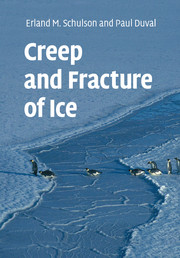Book contents
- Frontmatter
- Contents
- Preface
- Acknowledgements
- 1 Introduction
- 2 Structure of ice
- 3 Microstructure of natural ice features
- 4 Physical properties: elasticity, friction and diffusivity
- 5 Plastic deformation of the ice single crystal
- 6 Ductile behavior of polycrystalline ice: experimental data and physical processes
- 7 Modeling the ductile behavior of isotropic and anisotropic polycrystalline ice
- 8 Rheology of high-pressure and planetary ices
- 9 Fracture toughness of ice
- 10 Brittle failure of ice under tension
- 11 Brittle compressive failure of unconfined ice
- 12 Brittle compressive failure of confined ice
- 13 Ductile-to-brittle transition under compression
- 14 Indentation fracture and ice forces on structures
- 15 Fracture of the ice cover on the Arctic Ocean
- Index
- References
8 - Rheology of high-pressure and planetary ices
Published online by Cambridge University Press: 01 February 2010
- Frontmatter
- Contents
- Preface
- Acknowledgements
- 1 Introduction
- 2 Structure of ice
- 3 Microstructure of natural ice features
- 4 Physical properties: elasticity, friction and diffusivity
- 5 Plastic deformation of the ice single crystal
- 6 Ductile behavior of polycrystalline ice: experimental data and physical processes
- 7 Modeling the ductile behavior of isotropic and anisotropic polycrystalline ice
- 8 Rheology of high-pressure and planetary ices
- 9 Fracture toughness of ice
- 10 Brittle failure of ice under tension
- 11 Brittle compressive failure of unconfined ice
- 12 Brittle compressive failure of confined ice
- 13 Ductile-to-brittle transition under compression
- 14 Indentation fracture and ice forces on structures
- 15 Fracture of the ice cover on the Arctic Ocean
- Index
- References
Summary
Introduction
When subjected to high pressures and varying temperatures, ice can form in 12 known ordered phases. On Earth, only ice Ih is present because polar ice sheets are too thin to reach the critical conditions for the formation of ice II and ice III. The situation is very different for the large icy satellites of the outer planets. Temperature and pressure are such that current models of the internal structure of the principal moons of the outer planets suggest that a thick icy shell containing several high-pressure phases of ice surrounds the silicate core. The occurrence and properties of such ices are the subject of numerous studies to understand the tectonics and dynamics of these ices. A review of the main physical properties of high-pressure ices can be found in Klinger et al. (1985), Schmitt et al. (1998) and Petrenko and Whitworth (1999).
The regions of stability of ice crystalline phases on the pressure–temperature diagram are shown in Figure 8.1. Several phases are not mentioned in this figure because they are not stable or not present in icy satellites. In this chapter, the analysis of the mechanical properties of high-pressure ices is restricted to ices II, III, V and VI, the only ices studied in the laboratory. Crystalline structure, density and shear modulus of several phases of water ice are given in Table 8.1.
- Type
- Chapter
- Information
- Creep and Fracture of Ice , pp. 179 - 189Publisher: Cambridge University PressPrint publication year: 2009



